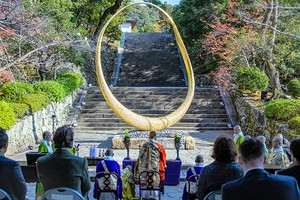By MASAFUMI KAMIMURA/ Staff Writer
April 26, 2024 at 17:39 JST
The spawning season for ito, often called “phantom fish,” is drawing to a close in the Kushirogawa river water system in eastern Hokkaido.
Ito are also known as Sakhalin taimen. It is one of the largest freshwater fish in Japan and a member of the salmon family.
Its natural breeding grounds in Japan are the northernmost main island of Hokkaido and the Northern Territories. But breeding has only been confirmed in a very limited number of rivers.
The International Union for Conservation of Nature and Natural Resources (IUCN) Red List of Threatened Species designates the fish as “critically endangered,” or CR.
The Environment Ministry also designates ito as endangered, meaning the fish is at high risk of extinction in the wild in the near future.
In eastern Hokkaido, April is the spawning season for ito.
An Asahi Shimbun reporter, camera in hand, recently had the rare chance to witness two male ito, each over 1 meter in length and their bodies red with ardor, battle fiercely for the attentions of a female.
During spawning season, the body of a male ito except its head turns red.
Local government road construction upstream of the location had brought a deluge of sediment to the spawning area.
As a result, the fry may not hatch.
The Asahi Shimbun reporter wondered what the spawning would be like in such conditions.
The reporter observed a male and a female pair of ito as a male rival, following the meandering current, approached.
There was a sudden splash of water as a battle between the two males got under way.
The male paired with the female put his body over the approaching male to prevent contact with the female.
The approaching male flipped his body over and bit the other male’s torso.
The battle occurred in shallow water only a few centimeters deep.
The bodies of the two males were mostly exposed to the air as the fight continued. It lasted for several dozen seconds.
Yellow fuchsia, called chiraiapappo by indigenous Ainu people, bloomed on the shore.




















A peek through the music industry’s curtain at the producers who harnessed social media to help their idols go global.
A series based on diplomatic documents declassified by Japan’s Foreign Ministry
Here is a collection of first-hand accounts by “hibakusha” atomic bomb survivors.
Cooking experts, chefs and others involved in the field of food introduce their special recipes intertwined with their paths in life.
A series about Japanese-Americans and their memories of World War II